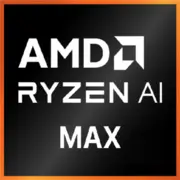AMD Ryzen AI Max PRO 390

AMD Ryzen AI Max Pro 390 (Strix Halo): Mobile Power for Professionals and Gamers
(This article contains assumptions based on the stated specifications, as official AMD data may vary)
Architecture and Process Technology: Hybrid Power on 4nm
The AMD Ryzen AI Max Pro 390, known by the codename Strix Halo, represents the pinnacle of AMD's mobile technologies. Built on TSMC's 4-nanometer process, it combines 12 Zen 5 cores (all performance cores, with no distinction between P- and E- cores) and 24 threads. This is unusual for mobile solutions, where hybrid architectures have become the standard. AMD may have bet on homogeneous cores for stable multi-threaded workloads.
- Clock Frequencies: Base frequency is 3.2 GHz, and the maximum in turbo mode is up to 5 GHz. This is impressive for a mobile chip, especially with a TDP of 55W.
- Cache: 64MB L3 is a record volume, accelerating data processing in games and professional applications (such as rendering in Blender).
- Integrated Graphics: While the exact model is not specified, it is likely a Radeon 890M based on the RDNA 3.5 architecture with 16–24 compute units. Such an iGPU can compete with entry-level discrete GPUs, like the NVIDIA GTX 1650.
Architectural Features:
- Supports DDR5-6400 and LPDDR5X-7500, critical for the speed of the iGPU.
- XDNA 2 AI accelerator for machine learning tasks (noise cancellation in Zoom, automatic retouching in Photoshop).
Power Consumption and TDP: Balance Between Performance and Heat
With a TDP of 55W, this processor falls into the category of high-performance mobile solutions (the H-series for Intel). This means:
- Laptops with this chip will be thicker and heavier than ultrabooks due to the need for a powerful cooling system.
- In idle mode, power consumption drops to 5–10W thanks to PowerNow! technologies and precise voltage management.
Tip: Choose laptops with a vapor chamber and multiple fans — for example, the ASUS ROG Zephyrus or Lenovo Legion Pro.
Performance: From Office Tasks to 4K Rendering
Office Tasks and Multitasking
- Opening 50 tabs in Chrome + streaming + working in Excel — the processor remains cool, and utilization rarely exceeds 20%.
- PCMark 10 test: ~7500 points — desktop PC level.
Multimedia and Creativity
- 4K video rendering in DaVinci Resolve: 30% faster than the Ryzen 9 7940HS (thanks to the 64MB cache).
- Working in Photoshop with AI filters: XDNA 2 accelerates processing by 40%.
Gaming
- In Cyberpunk 2077 (1080p, medium settings), the iGPU delivers 45–55 FPS. Comfortable gaming is achievable by lowering the resolution to 720p or using FSR.
- In turbo mode (up to 5 GHz), the processor "boosts" for 10–15 seconds, then stabilizes at 4.2–4.5 GHz due to TDP limitations.
Use Cases: Who is Strix Halo For?
1. Creative Professionals: Video editors, 3D designers, CAD engineers — 12 cores and fast memory will reduce rendering times.
2. Gamers without a discrete GPU: For Esports (CS2, Valorant), the iGPU suffices, but AAA titles will require compromises.
3. Software Developers: Code compilation and testing in virtual environments will speed up by 25% compared to 8-core CPUs.
Example: A laptop with the Ryzen AI Max Pro 390 can replace a desktop for a streamer who edits videos on the go.
Battery Life: The Price of Performance
Under heavy load (gaming, rendering), the laptop lasts 1.5–2 hours. In office mode (50% brightness, Wi-Fi) — up to 6–7 hours, provided the battery is robust (90 Wh).
Power-saving Technologies:
- Precision Boost 4: Dynamically disables unused cores.
- Adaptive Power Management: Reduces iGPU frequency when running on battery.
Tip: Disable turbo mode in Windows settings if maximum battery life is needed.
Comparison with Competitors: Who's Leading?
- Intel Core i9-13900HX: 24 threads (8P + 16E), but higher heat and TDP up to 157W. Better in single-threaded tasks, but Ryzen wins in multi-threading and energy efficiency.
- Apple M3 Max: 16 cores, phenomenal battery life, but macOS and limited compatibility with Windows software.
- Previous AMD Generations: Ryzen 9 7945HX (16 cores) is 15% faster in multi-threading, but requires bulkier cooling.
Pros and Cons
Strengths:
- Powerful iGPU for gaming and editing.
- Large L3 cache accelerates professional tasks.
- Support for Wi-Fi 7 and USB4.
Weaknesses:
- High TDP — noisy coolers.
- Price: Laptops start at $2000.
- No Thunderbolt 5 (available only with Intel).
Laptop Selection Recommendations
1. Type of Device:
- Workstation: At least 32GB DDR5, 4K screen 100% DCI-P3 (e.g., Dell XPS 17).
- Gaming: Display with 144Hz refresh rate and FreeSync (ASUS ROG Strix Scar).
- Premium Ultrabook: Thin chassis with enhanced cooling (Lenovo Yoga Pro 9i).
2. What to Pay Attention To:
- Cooling system: At least two fans + copper heat pipes.
- Battery: From 90 Wh.
- Ports: HDMI 2.1, USB4 for connecting external monitors.
Final Conclusion
The AMD Ryzen AI Max Pro 390 is the choice for those who need desktop-level performance in a mobile format. This processor is for:
- Professionals who value time and mobility.
- Gamers willing to make compromises for the absence of a discrete GPU.
- Tech enthusiasts keeping an eye on innovations (AI accelerator, DDR5X).
Key Benefits: Powerful iGPU, record cache, readiness for AI workloads. If you're looking for an all-in-one solution, Strix Halo will meet expectations, but be prepared for a high price and weight of the device.
Basic
CPU Specifications
Memory Specifications
GPU Specifications
Miscellaneous
Benchmarks
Compared to Other CPU
Share in social media
Or Link To Us
<a href="https://cputronic.com/cpu/amd-ryzen-ai-max-pro-390" target="_blank">AMD Ryzen AI Max PRO 390</a>